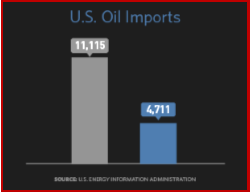
“Our decision about energy will test the character of the American people and the ability of the President and the Congress to govern this nation. This difficult effort will be the ‘moral equivalent of war,’ except that we will be uniting our efforts to build and not to destroy,” said President Carter in 1977. Energy dependence on the terrorist supporting governments in mid-east is now largely eliminated.
In a parting shot to Twit-nitwit Trump who wants to despoil the environment because global warming is all a “Chinese hoax,” EPA Administrator Gina McCarthy says it will maintain the current greenhouse gas (GHG) emissions standards for model years 2022-2025 for cars and light trucks. (EPA Keeps 54.5 MPG Fuel Economy Rules in Place, President Obama Unveils 54.5 MPG Fuel Economy Regulation for 2017-25.) The so-called “final determination” finds that a wide variety of technologies are available to reduce GHG emissions from cars and light trucks, and that automakers can meet the standards through model year 2025 at lower costs than predicted.
The real question here is whether the existing global warming regulations could now be increased since the technical record indicates the standards could be made more stringent. (DOT and EPA Issue Record 54.5 MPG Fuel Economy Standards)
“My decision today rests on the technical record created by over eight years of research, hundreds of published reports including an independent review by the National Academy of Sciences, hundreds of stakeholder meetings, and multiple opportunities for the public and the industry to provide input,” said EPA Administrator Gina McCarthy.
“At every step in the process the analysis has shown that the greenhouse gas emissions standards for cars and light trucks remain affordable and effective through 2025, and will save American drivers billions of dollars at the pump while protecting our health and the environment,” said McCarthy.
Naturally and predictably, self-interested participants that make huge money off the auto business are squealing, as they always do, about environmental matters and denying global warming. These standards that have broad, far reaching implications for U.S. national security, but it might cost them a nickel. (Fourth of July 2016 – Let’s Move Toward More Independence)
“We urge the incoming Trump Administration to withdraw today’s action, and we look forward to working with the new Administration to ensure that working families can choose the cleaner, safer new cars and trucks they need at prices they can afford,” said NADA President and CEO Peter Welch.
Piling on – or leading – was the Association of Global Automakers, which represents international motor vehicle manufacturers, original equipment suppliers, and other automotive-related trade associations: “The Environmental Protection Agency has still failed to state a compelling reason for rushing its final determination. It unnecessarily truncated public comment and prevented scrutiny of an important policy decision that will affect consumers, investment, public health and the environment. This can only undermine confidence in the objectivity of policy making. It merits a serious look by the incoming administration,” claimed John Bozzella, President and CEO.
The CAFE/Global Warming standards are projected to result in average fleet-wide consumer fuel economy sticker values of 36 miles per gallon by model year 2025, 10 mpg higher than the current fleet average. Since the first year of the GHG standards, manufacturers – after stalling regulatory fuel economy increases for decades – have been developing and adopting fuel economy technologies at unprecedented historical rates. At the same time, the American car industry is setting records under the Democratic recovery of the Republican-induced Great Recession. Since 2010, the auto industry has had seven consecutive years of sales growth (in spite of fierce Republican resistance to stimulus packages and help for automakers), with 2016 setting a record high for vehicle sales following one in 2015. (Earth Day Milestones – History of Auto Air Pollution Regs)
Retaining the current standards preserves the significant cuts in harmful carbon pollution expected from the original standards, and importantly provides regulatory certainty for a global auto industry that must meet similar standards in other markets, including Canada and Europe and Asia.
The Midterm Evaluation process was established as a part of the 2012 final greenhouse gas emissions standards for model years 2017-2025. This decision follows the s0-called Proposed Determination issued by the EPA in November 2016, and the Draft Technical Assessment Report, issued jointly by the EPA, the National Highway Traffic Safety Administration (NHTSA), and the California Air Resources Board (CARB) in July 2016. (EPA Keeps 54.5 MPG Fuel Economy Rules in Place)
“The Administrator considered the extensive public input on both these documents in reaching her final determination,” said EPA.
“From the CARB technical team’s perspective, the evidence in support of the standards is robust and definitive,” said Dr. Alberto Ayala, CARB’s Deputy Executive Officer of the California Air Resources Board. “This final determination is also timely and important as CARB prepares to consider its own mid-term review of the standards in March.”
For more information see: https://www.epa.gov/regulations-emissions-vehicles-and-engines/midterm-evaluation-light-duty-vehicle-greenhouse-gas-ghg


